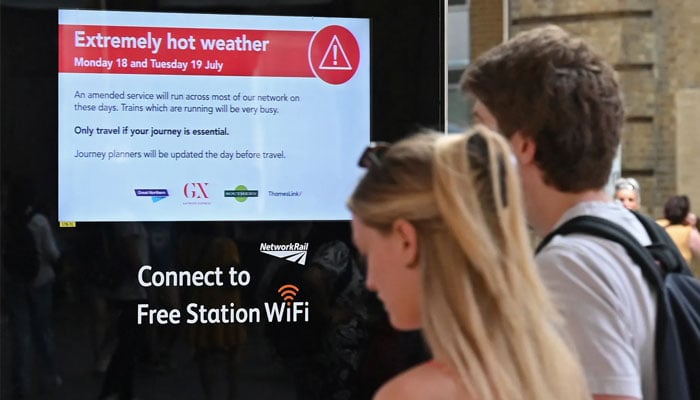The ever-increasing scorching heat poses a grave threat to human lives, infrastructure, and the environment

A heat warning sign at a train station in London. AFP/File
As temperatures continue to soar, cities worldwide are facing a daunting challenge to protect their citizens from the effects of extreme heatwaves.
The problem is becoming increasingly troublesome, with record-breaking temperatures reported in various regions, from the United States to India and Pakistan. Even if immediate actions are taken to cut down carbon emissions, experts predict that the rise in temperatures will persist for the next three decades. In the face of this escalating heat crisis, cities are stepping up to implement innovative strategies to safeguard their communities.
The scorching heat poses a grave threat to human lives, infrastructure, and the environment. Extreme heatwaves have already claimed hundreds of lives in various regions, with vulnerable populations at higher risk. The impact on the workforce is significant, as reduced productivity due to heat-related illnesses affects the economy, and students' academic performance declines in sweltering conditions.
City dwellers, constituting over half of the global population, are particularly vulnerable to the urban heat island effect. Asphalt, cement, glass, and steel, commonly found in cities, absorb and retain heat, leading to temperatures up to seven degrees Fahrenheit hotter than in rural areas. Recognising the severity of the situation, some cities have taken an innovative approach by appointing Chief Heat Officers (CHOs) to develop and execute plans to tackle rising temperatures.
Miami, Athens, Freetown, and other cities have already hired CHOs to address the unique challenges their communities face. These officers play a crucial role in coordinating responses and creating tailored solutions for their cities' diverse needs. For instance, Miami CHO, Jane Gilbert, spearheaded a data collection initiative to obtain accurate temperature readings, helping residents prepare for extreme heat and find cooler places.
Other cities, like Athens and Freetown, are focusing on urban planning and community engagement. Athens CHO, Eleni Myrivili, compiled a cooling guidebook featuring technical recommendations for green spaces and water features to mitigate heat's impact. Meanwhile, Freetown CHO, Eugenia Kargbo, has involved market stall workers in designing structures to shield them from the sun and raise awareness about heat risks.
In addition to CHOs' efforts, community involvement and awareness play a crucial role in countering the heatwave threat. Initiatives, such as emergency response training programmes and public categorisation of heatwaves, aim to educate citizens and empower them to provide aid when needed.
As we brace ourselves for what may be one of the coolest years in the next century, cities' proactive approach to protecting their residents offers hope for a cooler future. By fostering cooperation, innovation, and public engagement, cities worldwide are rising to the challenge of combating the effects of ever-increasing temperatures.









